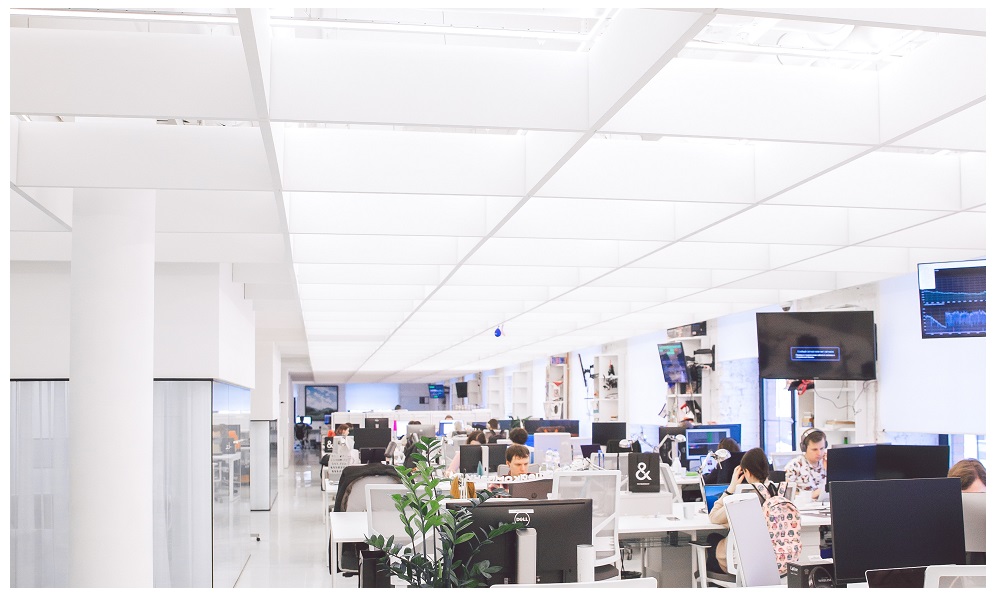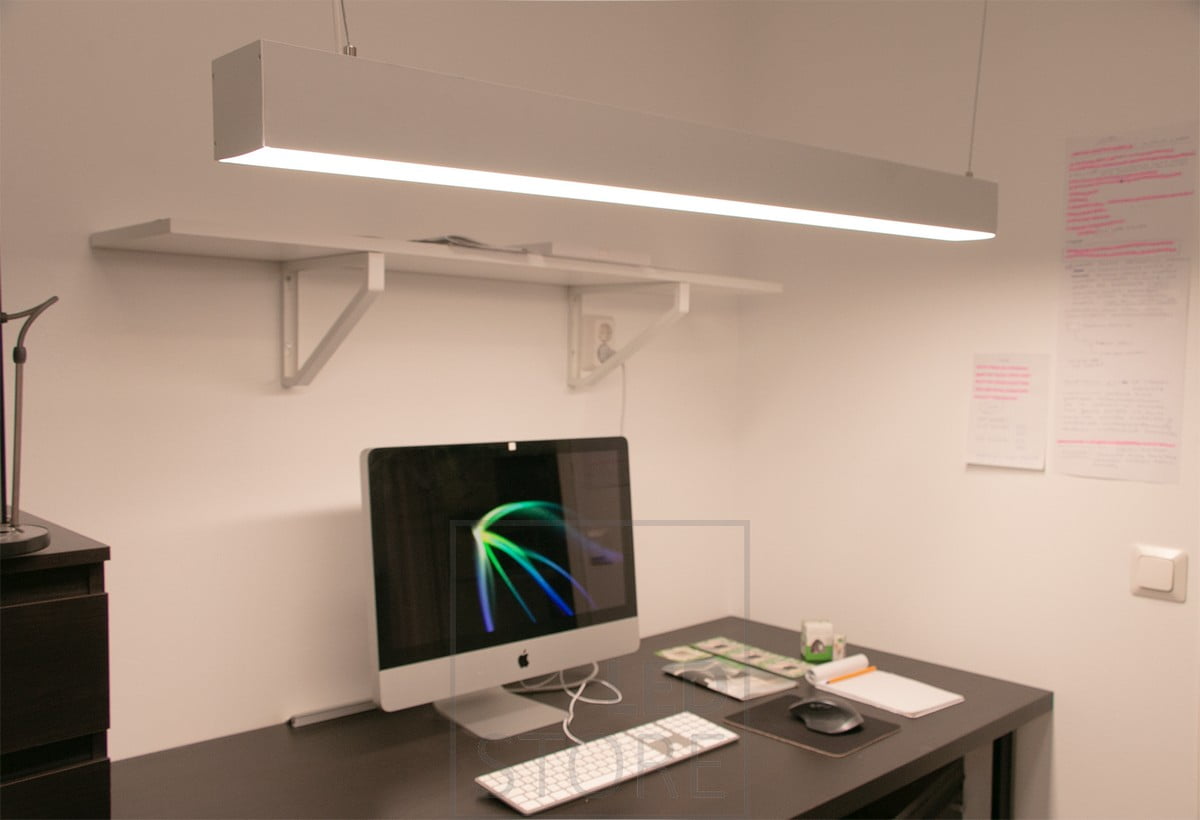Let’s get started! In addition to ergonomics, workplace lighting has a number of effects on the well-being and efficiency of workers. Properly designed lighting can increase work efficiency, reduce fatigue and improve concentration. In this article, we’ll go through how lighting design can help improve workplace productivity, and provide concrete tips on how to optimise lighting.
Basic principles of workplace lighting
First, it is good to understand the basic principles of lighting. Natural daylight is the most pleasant for people, so wherever possible, workspaces should make use of it. In northern Finland, this can be challenging, especially in winter, when artificial lighting is of great value. The basis of effective lighting design is the right combination of different lighting types: general lighting, task lighting and mood lighting.
General lighting
General lighting creates an even lighting level throughout the workspace. It allows workers to navigate the workplace and carry out basic tasks. For this type of lighting, LED fluorescent tubes or LED panels are usually preferred.

Task lighting
On the other hand, task lighting focuses on specific workplaces, such as at desks, where workers need a more efficient light source. Typical task lighting solutions include table luminaires and adjustable spotlights and pendant luminaires
Ambient lighting
Ambient lighting can be used to create a pleasant and inspiring atmosphere in the workplace. The use of colour, contrast and direction of light can create a visually rich environment that supports employee wellbeing and creativity. For example, indirect lighting such as reflected light on the wall or embedded LED strips can create a soft and pleasant atmosphere.
Lighting ergonomics in workplace lighting
Ergonomics plays no small role in lighting design. Workers need adequate lighting levels that do not strain the eyes or cause glare. Light levels should be easily adjustable to suit different work tasks and individual preferences.
We’ve written about how LED lights reduce eye strain and how lighting can contribute to overall eye health.

It is also important to consider the position of windows in relation to workstations to avoid distracting reflections and shadows. It’s disgusting when the light reflects directly off the monitor.
Workplace lighting in different spaces
Workplace lighting design should also take into account different workspaces and their needs.
Workshop
The actual workplace can be a landscape office or a dedicated office room. Depending on the tasks to be performed at the workstation, lighting should be provided in such a way that it is preferably adjustable in some way by the employee. The height of the workstation directly affects the height of the monitor, for example, and therefore how the reflections appear on the screen. This is especially true for the popular adjustable desks, where the lighting level of the workplace changes depending on the height of the desk.

Meeting facilities
Meeting room lighting should be flexible to suit both casual meetings and formal presentations.
Lighting should therefore be designed with direct working light, as well as indirect lighting that can be adjusted according to the situation.

Break rooms
And in employee break rooms, it’s a good idea to invest in comfortable and relaxing lighting that promotes employee recovery and a sense of community. Why not go bold with a colour scheme for a possible company party!
Energy efficiency in lighting design
Energy efficiency is an important aspect of lighting design, especially in Finland where electricity consumption is high. Energy-efficient lighting, such as LED lights, reduces electricity consumption and lowers the carbon footprint of the company. In addition, energy savings can be a significant economic benefit for the company.
Upgrading your workplace lighting may seem like a complex project, but it’s an investment that pays off in improved wellbeing and productivity. It’s a good idea to turn to professionals who can help you identify your needs and design lighting solutions that are both functional and aesthetically pleasing.
What are the benefits of LED lighting?
LED lighting has grown rapidly in recent years and offers many advantages over traditional light sources. Here are some of the key benefits that LED lighting offers for workplace lighting:
- Energy efficiency: LED lights consume less energy than conventional light sources, which means they save energy and reduce electricity bills. This makes LED lighting a very attractive option for businesses and households looking to save on energy costs.
- Lifetime: LED lights last much longer than conventional light sources. This means that LED lights do not need to be replaced as often, saving money and reducing the environmental impact.
- Low heat output: LED lights produce less heat than conventional light sources. This makes LED lighting a safer option, as they do not pose the same fire risk as traditional light sources.
- Colour temperature adjustment: the colour temperature of the LED lights can be adjusted as required. This means that LED lights can be used in a wide range of situations and spaces.
- Fast start-up: the LED lights up immediately and without delay. This makes them practical in situations where fast and efficient lighting is needed.
In addition to these benefits, LED lighting also offers many other advantages, such as environmental friendliness and versatility. LED lighting is an excellent choice for those who want to save energy, money and the environment while enjoying high quality and efficient lighting in the workplace.
Lastly
In summary, workplace lighting and its design play an important role in improving workplace productivity. Carefully considered workplace lighting can increase work efficiency, reduce fatigue and improve the comfort of the working environment. By taking into account the combination of different lighting modes, ergonomics, specific workplace requirements and energy efficiency, it is possible to create a workplace where employees feel comfortable and achieve the best possible work performance.
Led lighting expert
LedStore has been a specialist in Led lighting since 2010. We have our own product design, so our products are technologically state-of-the-art.
We focus on light colour temperature controlled and high colour rendering index lights. We do around 500 lighting designs in a year.
We offer a service of custom made led strips, i.e. custom made led light strips in profile. Also installed.
Remember that we are always ready to offer our help to you along the way, by email (myynti@ledstore.fi) and by phone (045 251 4510). As always, feel free to share photos of your own projects on social media at ledstore.fi at Instagram and ledstore.fi at Meta. We love to see the cool things done by our LEDs, and it also helps to provide inspiration for those who are not sure about the power and awesomeness of LEDs. Did you know that we already have over 3500 pictures of our LED installations in our Gallery!
Gallery of Led lights:
Product gallery: Pictures of products in different installation locations
Indirect light: Indirect light in different spaces
Room-specific: Light in different rooms
References: Complete houses that have been photographed

